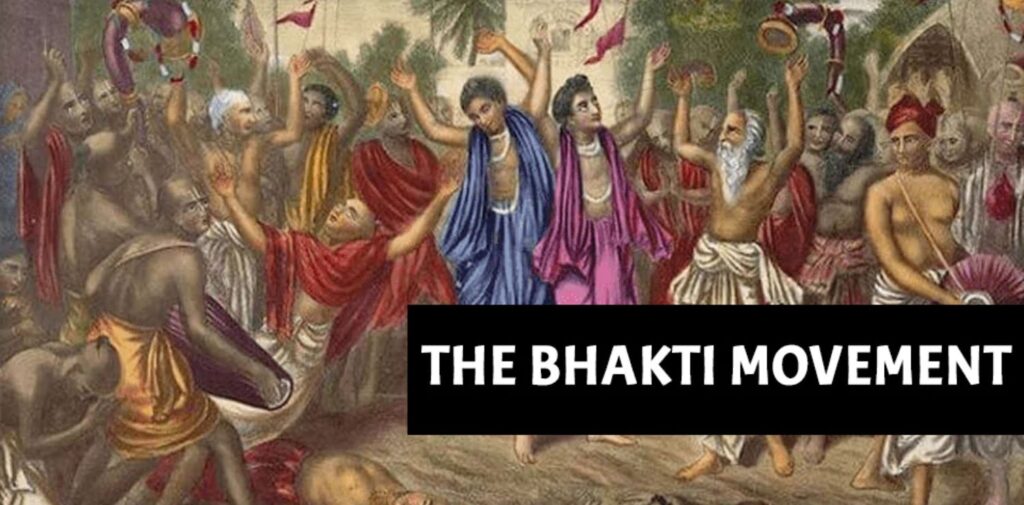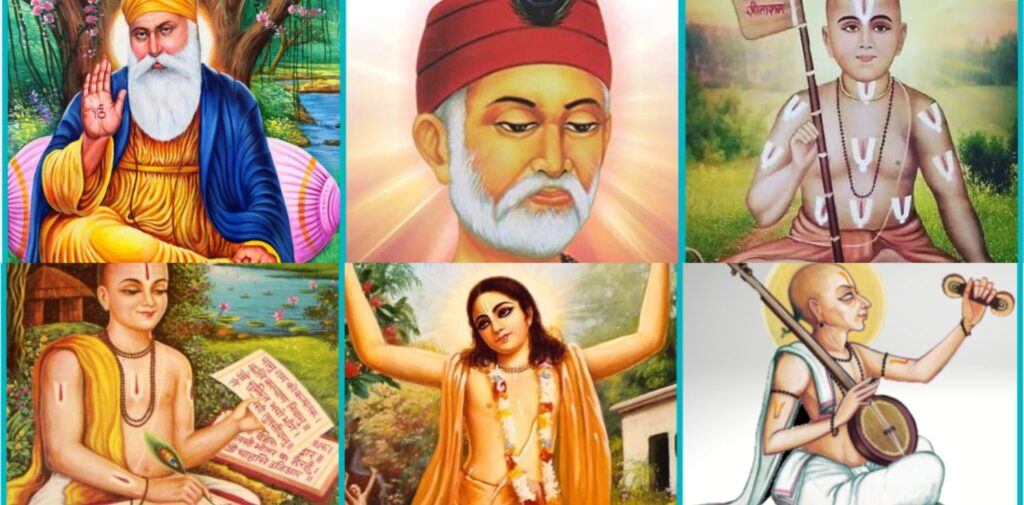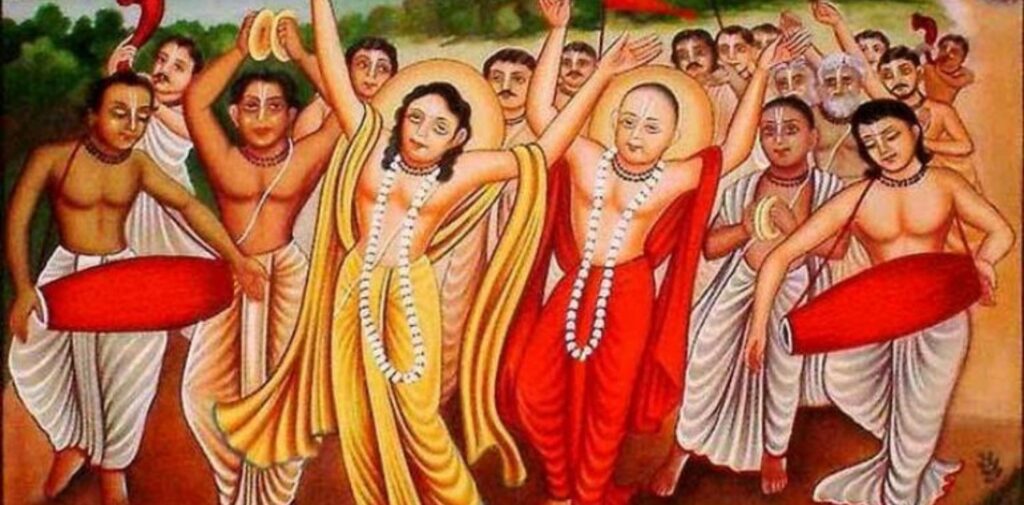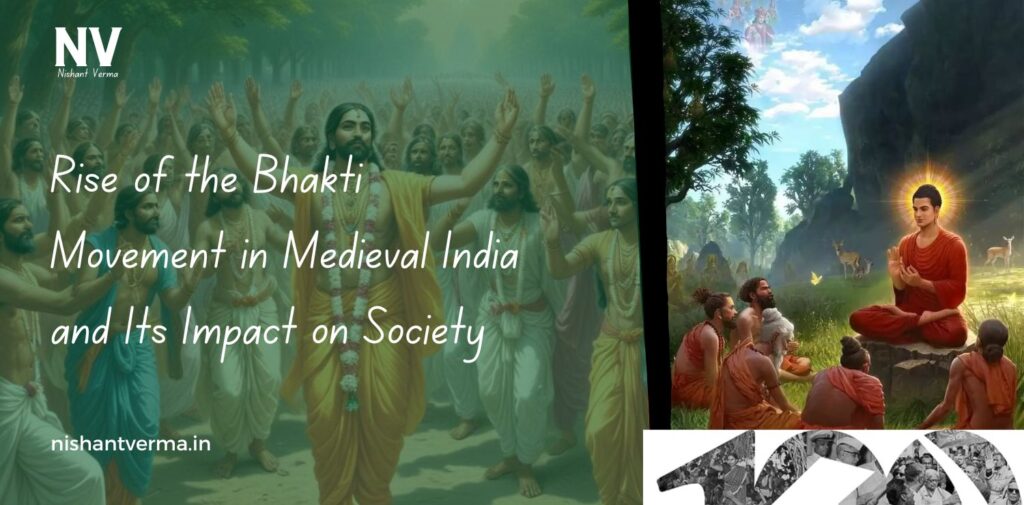The Bhakti Movement, a significant religious and cultural transformation, emerged in medieval India. It was a devotional movement that focused on the worship of a personal god through love and devotion. The Bhakti movement spread across India during the medieval period, roughly between the 7th and 17th centuries, and had a lasting impact on the social, religious, and cultural landscape of the subcontinent.
Origin and Development of the Bhakti Movement
The Bhakti Movement had its roots in the Tamil region of South India, where the Alvars and Nayanars, two groups of poet-saints, began expressing their devotion to God through songs and hymns. These saints, who lived between the 6th and 9th centuries, primarily worshipped Lord Vishnu and Lord Shiva. Their devotion was personal and direct, as opposed to the formal rituals and sacrifices of the traditional Vedic practices.
As time passed, the idea of Bhakti spread to other parts of India. It was adopted and developed by various saints and reformers in different regions. One of the main reasons for the spread of Bhakti was its emphasis on a personal, emotional connection with God, rather than rigid religious rituals. Bhakti, in this sense, offered an alternative to the hierarchical and ritualistic practices of traditional Hinduism.

Key Features of the Bhakti Movement
- Devotion and Love for God: Bhakti focused on the emotional bond between the devotee and the deity. Bhaktas (devotees) believed that through devotion, they could attain salvation (moksha). This personal connection with the divine was open to all, irrespective of caste, creed, or gender.
- Rejection of Rituals: The Bhakti saints opposed the complex rituals, sacrifices, and priestly intermediaries that dominated the religious practices of the time. They argued that true devotion did not require expensive ceremonies or the services of priests. Instead, love and devotion were the only true means to connect with God.
- Equality and Social Reform: Many Bhakti saints preached equality among people. They rejected the caste system, which had been deeply entrenched in Indian society. Bhakti saints believed that all humans, regardless of their caste or social standing, were equal in the eyes of God. This was a radical shift in a society where caste determined one’s status and privileges.
- Emphasis on Vernacular Language: One of the most important aspects of the Bhakti Movement was the use of regional and vernacular languages to express devotion. Instead of using Sanskrit, the language of the elite and scholars, Bhakti poets and saints composed hymns and devotional songs in the languages spoken by the common people. This made Bhakti accessible to everyone, irrespective of their education or social status.

Prominent Bhakti Saints
- Ramanuja (1017–1137): A great philosopher and theologian from Tamil Nadu, Ramanuja is considered one of the earliest figures to promote Bhakti in South India. He emphasized the worship of Vishnu and introduced the concept of Vishishtadvaita (qualified non-dualism), which proposed that while the soul and God are distinct, they are still inseparable.
- Kabir (1440–1518): Kabir was a mystic poet and saint whose works are still highly respected today. Born in a Muslim family, Kabir’s teachings blended elements of both Hinduism and Islam. He rejected the rigid structures of both religions and advocated for the worship of a formless, universal God, often called the “One Supreme Reality.” His poetry emphasized love, devotion, and spiritual wisdom, transcending sectarian boundaries.
- Guru Nanak (1469–1539): The founder of Sikhism, Guru Nanak emphasized the importance of devotion to one God. His teachings also stressed the equality of all people, regardless of their caste, gender, or religion. Guru Nanak’s contributions played a significant role in shaping the Bhakti movement in North India.
- Tulsidas (1532–1623): Tulsidas was a prominent figure in the Bhakti Movement in North India. He is best known for writing the Ramcharitmanas, a retelling of the Ramayana in Hindi. Through his work, he popularized the worship of Lord Rama and played a significant role in making the Bhakti movement more accessible to the masses.
- Meerabai (1498–1547): A Rajput princess and a passionate devotee of Lord Krishna, Meerabai became one of the most well-known female saints in Indian history. She composed devotional songs (bhajans) that expressed her deep love for Krishna. Despite facing immense societal pressures, she devoted herself entirely to her faith.

Impact of the Bhakti Movement on Society
- Religious Reforms: The Bhakti Movement was a response to the growing influence of ritualistic practices and the hierarchical structure of the caste system. By rejecting the need for elaborate rituals, priests, and sacrifices, the Bhakti saints democratized religion. Bhakti emphasized that anyone, regardless of their background, could achieve spiritual fulfillment through love and devotion to God.
- Social Reforms and Equality: The Bhakti Movement had a profound effect on the social fabric of India. The emphasis on equality among all people, regardless of caste or gender, challenged the rigid caste-based society. Several Bhakti saints, such as Kabir and Guru Nanak, openly criticized the discrimination and oppression faced by lower-caste people, women, and the marginalized. This led to the rise of a more inclusive society where people from different social backgrounds could come together in religious devotion.
- Cultural and Linguistic Influence: The use of local and vernacular languages for religious expression during the Bhakti Movement contributed to the flourishing of regional literature and arts. Saints like Kabir, Tulsidas, and Meerabai composed poetry and songs in languages like Hindi, Punjabi, and Marathi, making their teachings accessible to a much wider audience. This also gave rise to a rich tradition of devotional music, which continues to be an essential part of Indian culture today.
- Art and Architecture: The Bhakti Movement influenced art, music, and architecture across India. Temples dedicated to Bhakti deities were built, and devotional music and dance forms, such as bhajan and kirtan, became integral to religious and cultural practices. These forms of art and music continue to be important in Indian religious life.
- Interfaith Harmony: The Bhakti Movement also helped bridge the gap between Hinduism and other religious traditions. Saints like Kabir, who rejected the distinctions between Hinduism and Islam, promoted the idea of a universal God. This inclusive attitude led to greater interfaith dialogue and tolerance, reducing religious conflicts.
- Influence on Later Movements: The Bhakti Movement laid the foundation for several later reform movements in India, such as the Sikh, Sant, and Bhakti traditions of Maharashtra and Bengal. The teachings of Bhakti saints also influenced modern social reformers like Swami Vivekananda and Mahatma Gandhi, who promoted the values of equality, devotion, and service.
Conclusion
The Bhakti Movement was a transformative force in medieval India, bringing about significant religious, social, and cultural changes. By emphasizing personal devotion to God, rejecting rigid rituals, and advocating for social equality, the Bhakti saints challenged the existing norms and opened the doors for a more inclusive and accessible spirituality. The movement’s influence can still be seen in modern-day India, where the principles of devotion, equality, and cultural diversity continue to shape the society. The Bhakti Movement was not just a religious movement; it was a social revolution that contributed to the development of a more united and compassionate society.




